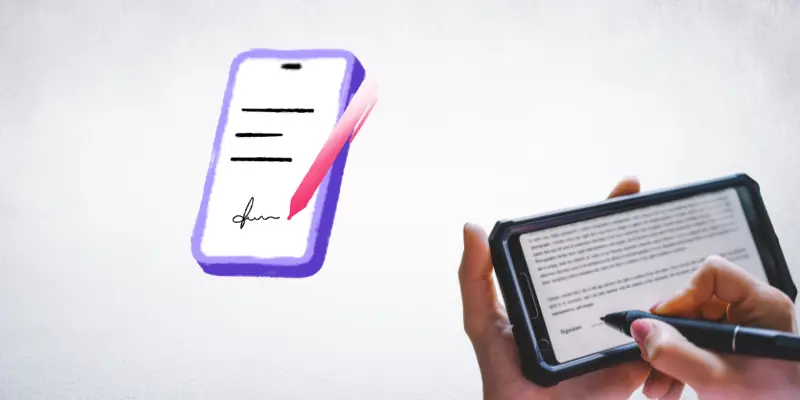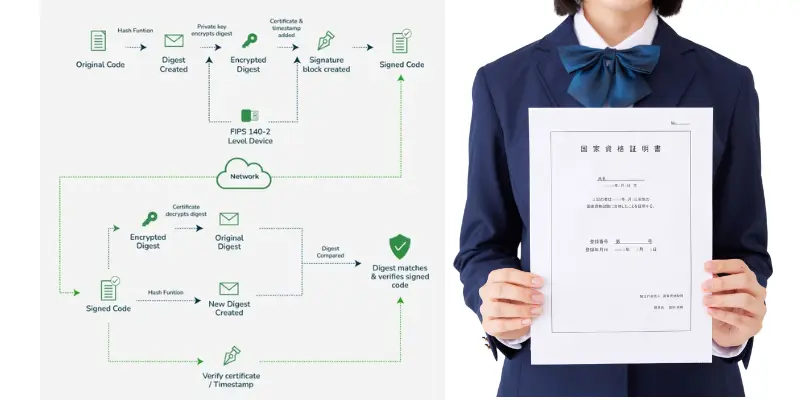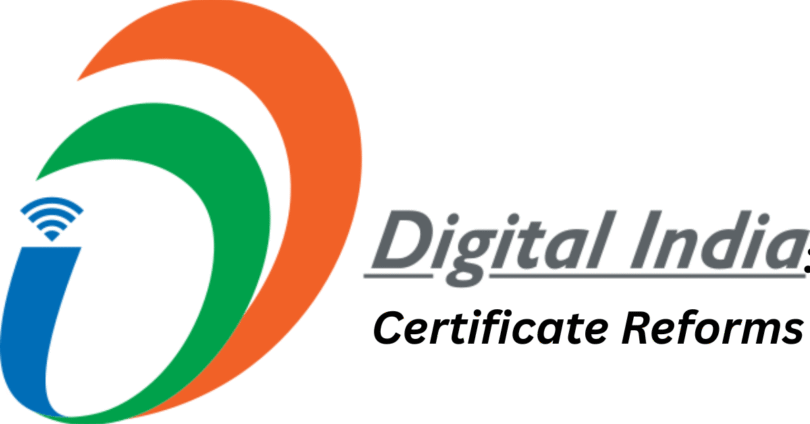Digital India: Certificate Reforms are transforming how millions of people across the country access and share their important documents. Instead of waiting in long lines, filling out endless paper forms, or carrying stacks of certificates, citizens can now receive and store their documents online safely and instantly. This major shift is part of India’s bold digital mission to make government services faster, smarter, and more transparent. By using tools like e‑Sign, DigiLocker, and Aadhaar-based verification, these reforms are cutting down delays, reducing fraud, and putting power directly in the hands of everyday people even in the most remote villages.
Electronic And Certificate‑Based Digital Signatures
Digital India: Certificate Reforms are changing how documents are signed and verified across the country and at the heart of this change are electronic and certificate-based digital signatures. These digital India: tools allow people to sign official documents online without printing anything or visiting a government office.

Instead of a pen, users now use secure technology linked to Aadhaar or a trusted certificate authority to prove their identity. This not only saves time but also keeps documents safe from tampering or fraud. With just a few clicks, certificates can be signed, sent, and accepted anywhere in India making the entire process faster, cleaner, and much easier for everyone.
How Digital India Is Reducing the Physical Certificate Burden
Managing paper certificates used to be a big problem for students, job seekers, and even government employees. But thanks to Digital India: Certificate Reforms, this heavy burden is now getting much lighter. People no longer need to carry stacks of paper or worry about losing their original documents. Instead, everything is moving online fast, safe, and simple. Here’s how these reforms are helping reduce the physical certificate burden:
- No More Paper Hassles: Birth, income, caste, and education certificates can now be issued and received digitally.
- Access Anytime, Anywhere: Through DigiLocker, users can store all their documents in one place and access them 24/7.
- No Need to Carry Originals: Digital certificates are accepted by most government and private organizations.
- Safe and Tamper-Proof: Certificate authenticity is protected by digital signatures and secure verification systems.
- Eco-Friendly and Efficient: Less paper means less waste good for the environment and government budgets.
- Faster Application Processes: College admissions, job applications, and government services are now quicker with e-documents.
Strong Government Support Behind Digital India’s Certificate Reforms
The success of Digital India: Certificate Reforms is only possible because of strong government planning, policies, and support systems. From national-level initiatives to local platform rollouts, the government has built a digital backbone that helps every citizen especially students, job seekers, and rural families benefit from fast and secure digital certificates. Here are some key government steps that are making these reforms successful:
- Digital India Mission: A national campaign that aims to make government services available online and digitally empower every citizen.
- DigiLocker Launch: A secure cloud platform where citizens can store and access their certificates anytime, without physical copies.
- e-Sign Services: The government supports digital signatures linked to Aadhaar, which allow users to legally sign documents online.
- National Academic Depository (NAD): A digital database where students’ degrees and mark sheets are safely stored and can be verified easily.
- State Platforms Like Simple Gov: States like Tamil Nadu launched portals to make certificate application and delivery faster and paperless.
- Cybersecurity Measures: Government has put strict security and privacy rules in place to keep user data and certificates safe.
- Awareness & Training Programs: Local workshops and Common Service Centres (CSCs) are teaching people how to use these digital tools.
How Citizens Get Started with Digital Certificates
Many people are still unsure how to begin using the services offered under Digital India: Certificate Reforms, but the truth is it’s easier than you might think. Whether you live in a big city or a small village, these digital tools are made for everyone to use. All you need is a smartphone or computer and a few basic steps to follow. Here’s how you can get started today:

1. Link Your Aadhaar
Make sure your Aadhaar number is active. Most digital services use Aadhaar for secure identity verification.
2. Create a DigiLocker Account
Go to digilocker.gov.in and sign up using your mobile number and Aadhaar. This is your digital folder for storing all certificates.
3. Use e‑Sign to Sign Documents
You can sign certificates online without printing them — just click “e‑Sign” and verify with your Aadhaar OTP.
4. Apply for Certificates on Government Portals
Visit your state’s e‑district portal (like SimpleGov) to apply for birth, income, caste, or education certificates.
5. Store & Share Certificates
Once approved, your certificates will be saved in DigiLocker. You can show or send them anytime from your phone.
6. Visit a Common Service Centre (CSC) if Needed
If you don’t have a phone or internet, nearby CSCs can help you with everything face-to-face.
Advantages and disadvantages of Digital India: Certificate Reforms
Digital India: Certificate Reforms have brought many pros to people across the country, they also come with some cons.
| Pros of Digital India: Certificate Reforms |
| More Secure: Digital certificates are harder to fake and easy to verify. |
| More Transparency: Reduces corruption and manual errors in offices. |
| Faster Services: Certificates are issued in minutes, not days. No need to stand in long lines. |
| Eco-Friendly: Less paper means less waste and more green solutions. |
| Anywhere Access: People can use DigiLocker to access their documents from any phone or computer. |
| Cons of Digital India: Certificate Reforms |
| Tech Challenges: Elderly or less-educated people may find it hard to use online systems. |
| Privacy Concerns: Data stored online must be protected one mistake can leak sensitive info. |
| System Errors: Sometimes the digital platforms crash or don’t work properly during high usage. |
| Lack of Awareness: Many citizens still don’t know how to use services like e‑Sign or DigiLocker. |
| Internet Dependence: People in remote areas may not have strong internet to access their digital certificates. |
Common FAQs About Digital India: Certificate Reforms
People across India are still learning how Digital India: Certificate Reforms work. These quick answers will help you understand the most important things in the simplest way.
What are Digital India: Certificate Reforms?
These are changes made by the Indian government to move official certificates (like birth, income, caste, and education) from paper to digital format. It saves time and makes everything easier and faster.
Are digital certificates as valid as paper ones?
Yes, under Digital India: Certificate Reforms, digital certificates signed using e‑Sign are legally accepted everywhere by schools, offices, and government departments.
How can I store my certificates online?
You can use DigiLocker. It’s a free and secure digital folder where your certificates are stored safely and can be accessed anytime with your phone or computer.
What if I don’t know how to use a computer?
No problem! You can visit your nearest Common Service Centre (CSC) where trained staff will help you with everything from registering on DigiLocker to applying for certificates.
Is it safe to keep my documents online?
Yes. The government uses strong security tools to protect your information. Just make sure you don’t share your Aadhaar OTP or passwords with anyone.
Do I need the internet every time?
You need the internet to apply or download certificates. But once saved, your documents can also be viewed offline through the DigiLocker mobile app.
Can people in villages also use these services?
Absolutely. Digital India: Certificate Reforms are made for everyone — in big cities and small villages. With mobile phones and CSCs, even rural citizens can benefit easily.
Conclusion
Digital India: Certificate Reforms have opened the door to a faster, safer, and more transparent way of handling official documents. From saving time to reducing paperwork, these reforms are helping citizens live smarter in the digital age. While some challenges remain, the benefits far outweigh the barriers. With continued support and awareness, every Indian from students to seniors can enjoy the power of digital documentation. This is not just a reform; it’s a revolution in how India connects with its people.







